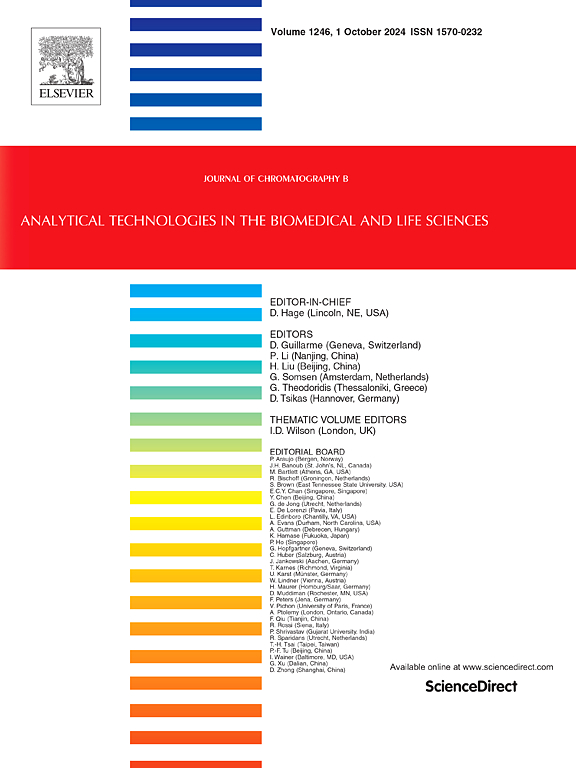Spectrum-effect relationship between HPLC fingerprints and antitumor activities of Inonotus hispidus
IF 2.8
3区 医学
Q2 BIOCHEMICAL RESEARCH METHODS
引用次数: 0
Abstract
Inonotus hispidus (I. hispidus), a traditional edible and medicinal fungus, has been widely used in the fields of medicine and health care. Modern pharmacological studies have confirmed that this fungus exhibits various biological activities, including antitumor, antioxidant, and hypoglycemic effects. However, the underlying mechanisms linking its antitumor activity to specific chemical constituents have not yet been fully elucidated. In this study, HPLC fingerprints of 11 batches of I. hispidus were established. The inhibitory effects of these samples on 4 T1 and HeLa cells were evaluated using the MTT assay. The correlation between the HPLC fingerprints and antitumor activity was analyzed using grey relational analysis and partial least squares regression. The results indicated that the antitumor activity of I. hispidus was due to the synergistic effects of multiple components. Of these, peaks 3, 5 (hispidin), 6, and 7 were identified as key contributors. Notably, these key components were predominantly enriched in the ethyl acetate fraction. The accuracy of the correlation results was validated by performing in vitro inhibition of 4 T1 cell viability using different extraction solvents. This study provides scientific evidence for the antitumor potential of I. hispidus and helps clarify the spectrum–effect relationship of its active components
牛皮草HPLC指纹图谱与抗肿瘤活性的光谱效应关系
牛皮菌(Inonotus hispidus)是一种传统的食药用菌,在医药保健领域有着广泛的应用。现代药理学研究证实,这种真菌具有多种生物活性,包括抗肿瘤、抗氧化和降血糖作用。然而,将其抗肿瘤活性与特定化学成分联系起来的潜在机制尚未完全阐明。在本研究中,建立了11批海棘草的HPLC指纹图谱。采用MTT法评估这些样品对4 T1和HeLa细胞的抑制作用。采用灰色关联分析和偏最小二乘回归分析了HPLC指纹图谱与抗肿瘤活性的相关性。结果表明,海鞘草的抗肿瘤活性是多种成分协同作用的结果。其中峰3、峰5 (hispidin)、峰6和峰7被认为是关键贡献者。值得注意的是,这些关键成分主要富集于乙酸乙酯部分。通过不同提取溶剂对4 T1细胞活力的体外抑制,验证了相关性结果的准确性。本研究为蛇皮草的抗肿瘤潜力提供了科学依据,并有助于阐明其有效成分的谱效关系
本文章由计算机程序翻译,如有差异,请以英文原文为准。
求助全文
约1分钟内获得全文
求助全文
来源期刊

Journal of Chromatography B
医学-分析化学
CiteScore
5.60
自引率
3.30%
发文量
306
审稿时长
44 days
期刊介绍:
The Journal of Chromatography B publishes papers on developments in separation science relevant to biology and biomedical research including both fundamental advances and applications. Analytical techniques which may be considered include the various facets of chromatography, electrophoresis and related methods, affinity and immunoaffinity-based methodologies, hyphenated and other multi-dimensional techniques, and microanalytical approaches. The journal also considers articles reporting developments in sample preparation, detection techniques including mass spectrometry, and data handling and analysis.
Developments related to preparative separations for the isolation and purification of components of biological systems may be published, including chromatographic and electrophoretic methods, affinity separations, field flow fractionation and other preparative approaches.
Applications to the analysis of biological systems and samples will be considered when the analytical science contains a significant element of novelty, e.g. a new approach to the separation of a compound, novel combination of analytical techniques, or significantly improved analytical performance.
 求助内容:
求助内容: 应助结果提醒方式:
应助结果提醒方式:


